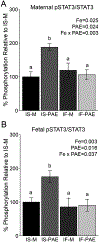Alcohol's Dysregulation of Maternal-Fetal IL-6 and p-STAT3 Is a Function of Maternal Iron Status
- PMID: 31524964
- PMCID: PMC7001854
- DOI: 10.1111/acer.14200
Alcohol's Dysregulation of Maternal-Fetal IL-6 and p-STAT3 Is a Function of Maternal Iron Status
Abstract
Background: Prenatal alcohol exposure (PAE) causes long-term growth and neurodevelopmental deficits that are worsened by maternal iron deficiency (ID). In our preclinical rat model, PAE causes fetal anemia, brain ID, and elevated hepatic iron via increased maternal and fetal hepcidin synthesis. These changes are normalized by a prenatal iron-fortified (IF) diet. Here, we hypothesize that iron status and PAE dysregulate the major upstream pathways that govern hepcidin production-EPO/BMP6/SMAD and IL-6/JAK2/STAT3.
Methods: Pregnant, Long Evans rat dams consumed ID (2 to 6 ppm iron), iron-sufficient (IS, 100 ppm iron), or IF (500 ppm iron) diets and received alcohol (5 g/kg) or isocaloric maltodextrin daily from gestational days (GD) 13.5 to 19.5. Protein and gene expression were quantified in the 6 experimental groups at GD 20.5.
Results: PAE did not affect Epo or Bmp6 expression, but reduced p-SMAD1/5/8/SMAD1/5/8 protein ratios in both IS and ID maternal and fetal liver (all p's < 0.01). In contrast, PAE stimulated maternal hepatic expression of Il-6 (p = 0.03) and elevated p-STAT3/STAT3 protein ratios in both IS and ID maternal and fetal liver (all p's < 0.02). PAE modestly elevated maternal Il-1β, Tnf-α, and Ifn-γ. Fetal cytokine responses to PAE were muted compared with dams, and PAE did not affect hepatic Il-6 (p = 0.78) in IS and ID fetuses. Dietary iron fortification sharply attenuated Il-6 expression in response to PAE, with IF driving a 150-fold decrease (p < 0.001) in maternal liver and a 10-fold decrease (p < 0.01) in fetal liver. The IF diet also normalized p-STAT3/STAT3 ratios in both maternal and fetal liver.
Conclusions: These findings suggest that alcohol-driven stimulation of the IL-6/JAK2/STAT3 pathway mediates the elevated hepcidin observed in the PAE dam and fetus. Normalization of these signals by IF suggests that dysregulated hepcidin is driven by alcohol's disruption of the IL-6/JAK2/STAT3 pathway. Prenatal dietary IF represents a potential therapeutic approach for PAE that warrants further investigation.
Keywords: Fetal Alcohol Spectrum Disorder; Hepcidin; IL-6; Iron Deficiency; Iron Fortification.
© 2019 by the Research Society on Alcoholism.
Figures









References
-
- Ahluwalia B, Wesley B, Adeyiga O, Smith DM, Da-Silva A, Rajguru S (2000) Alcohol modulates cytokine secretion and synthesis in human fetus: an in vivo and in vitro study. Alcohol 21:207–213. - PubMed
-
- Bustin SA, Benes V, Garson JA, Hellemans J, Huggett J, Kubista M, Mueller R, Nolan T, Pfaffl MW, Shipley GL, Vandesompele J, Wittwer CT (2009) The MIQE Guidelines : Minimum Information for Publication of Quantitative Real-Time PCR Experiments. Clin Chem 55:1–12. - PubMed
Publication types
MeSH terms
Substances
Associated data
- Actions
- Actions
- Actions
- Actions
- Actions
- Actions
- Actions
- Actions
Grants and funding
LinkOut - more resources
Full Text Sources
Research Materials
Miscellaneous

